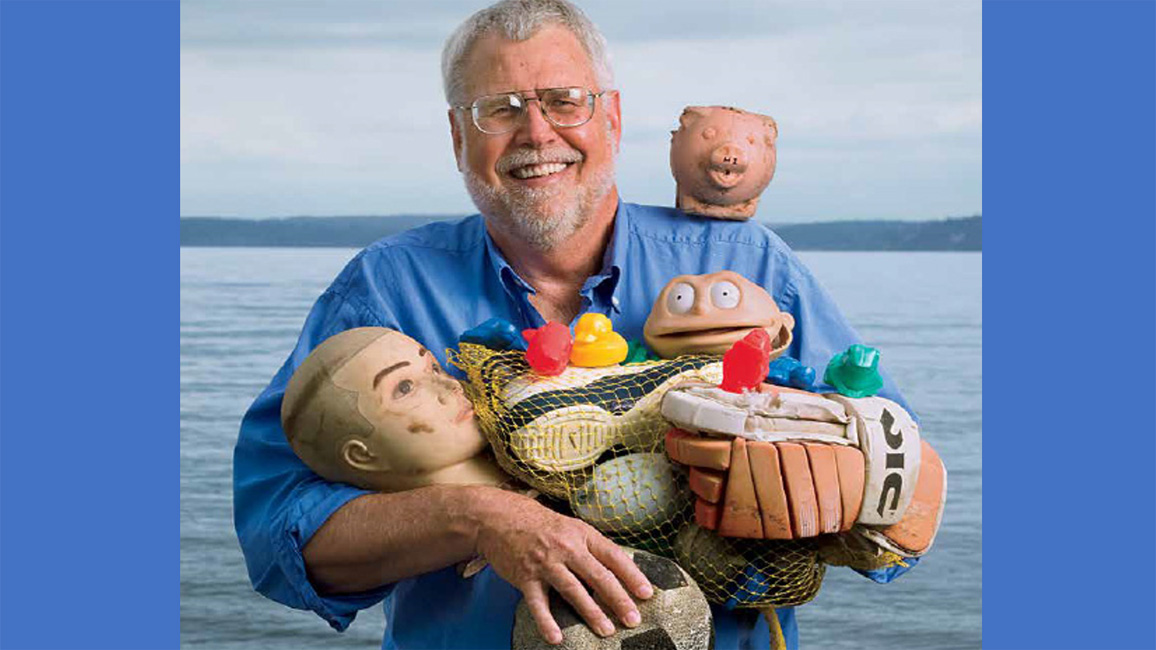
Trash Tracker
By Loree Griffin Burns; Photos by Rich FrishmanHave you ever found a sneaker in the sand? Or a plastic duck in the surf? Beach trash reveals secrets about ocean motion—and this man can tell you why.

Curt Ebbesmeyer is an oceanographer (oh-shun-AH-gruh-fur), a scientist who studies the ocean. He is especially interested in the fast-moving “rivers” of seawater called surface currents. Most people who study these currents use expensive, high-tech floats at they track by satellite. But Curt has a simpler approach: He tracks trash.
You wouldn’t believe some of the wacky things Curt uses in his studies: sneakers, bathtub toys, soccer balls, hockey gloves, flipflops, computer monitors, and even bags of tortilla chips! Where does he get this stuff? The items spill from cargo ships as they cross the ocean. If they float, Curt can use them to learn about surface currents.

SECRETS OF TRASH
Curt began tracking trash in 1990, after a big storm struck the Pacific Ocean. During the storm, a cargo ship was crossing from South Korea to the west coast of the United States. Huge waves washed several containers of Nike sneakers off the ship’s deck. Each container was the size of a semi-trailer. When the containers split open, 60,000 sneakers spilled into the sea. Curt realized that this flotilla of footwear could be very useful.
“I wandered along the coast near Seattle, Washington, and asked anyone I saw about the sneakers,” he says. “Soon, beachcombers started to call me with news of their finds.”
With help from these beachcombers, Curt located more than 1,300 of the sneakers. A few had floated to the Hawaiian Islands—and were still wearable when they got there! Most washed ashore along the west coast of North America.
For each shoe, Curt wrote down two important details: when and where it was found. Why? He knew the exact date and location of the sneaker spill. So, if he knew when and where the shoes came ashore, he’d learn a lot about the surface currents that carried them. He could estimate the speeds of the currents and the directions in which they flow.
Curt follows these same steps each time he hears of a new spill. Then, the information he collects gets plugged into a computer to create a picture of the ocean currents (see page 34). The more information Curt adds, the better this computer program can predict the motion of real currents. And that’s important, because scientists all over the world use the program. It helps them do many things: understand storms and climate, study the migration of sea animals, track oil spills and other pollution, and even find lost ships.
TRASH IS . . . TRASH
Curt has figured out a good use for cargo spills. But he points out that the trash is very bad for the ocean environment. Most of it is plastic, which can drift for years and years without sinking. Birds, turtles, and other animals can mistake the trash for food or get tangled in it.
Plastic doesn’t biodegrade as, say, an apple core would. But over time, it does break down into smaller and smaller bits. And even then, it causes big problems.
“The plastic degrades into dust,” says Curt. “Sea animals eat it, seeing it as tiny plant and animal life called plankton.” That can make them sick.

SEA DUMP
As oceanographers learn more about ocean currents, they can predict where trash will end up. In the North Pacific Ocean, the currents swirl around in a big circle, called a gyre (JYER). Trapped inside that gyre is an enormous area known as the “Great Pacific Garbage Patch.” (See map.) It’s made up of plastic trash that spreads from the surface to the floor of the ocean.
Cleaning up this huge mess seems impossible, though some people are trying. To keep things from getting worse, the problem must be tackled from shore.
CLEANING UP
It turns out that only a small amount of the trash clogging our oceans falls off ships. Most starts out on land. For instance, plastic bags and water bottles on a sidewalk wash into storm drains when it rains. The drains empty into rivers, which then carry the litter to the sea. The wind carries more trash from garbage trucks and landfills into rivers and oceans.
The good news is that—even if you don’t live near a beach—you and your family can be part of the solution. The first step, of course, is to recycle and be careful to never litter. Even more important is to find ways to use less plastic in the first place.
Another way to help is to join the International Coastal Cleanup. Every September, kids and adults around the world take part in this beach cleanup event, picking up trash and recording each item they collect. You’ll be cleaning up the ocean and helping people learn more about it at the same time!
Rangers: For more about the International Coastal Cleanup, have an adult visit coastalcleanup.org. —R.R.
















